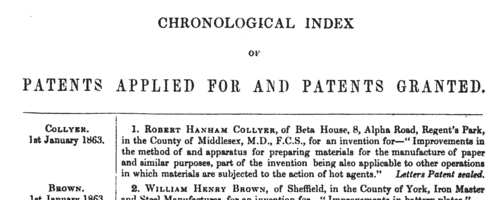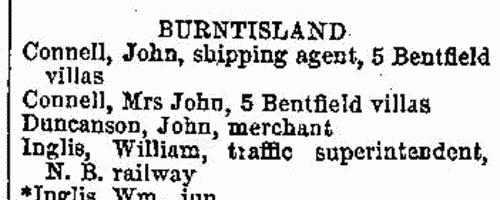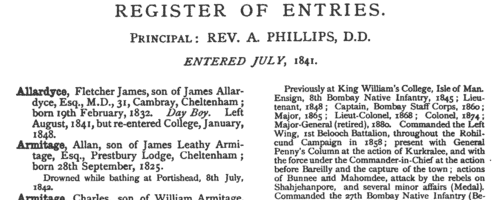Add this eBook to your basket to receive access to all 239 records. Our indexes include entries for the spelling rodger. In the period you have requested, we have the following 239 records (displaying 91 to 100): These sample scans are from the original record. You will get scans of the full pages or articles where the surname you searched for has been found. Your web browser may prevent the sample windows from opening; in this case please change your browser settings to allow pop-up windows from this site. Customs Officers in Montrose
(1858)
Complete lists of serving customs officers and clerks in the Port of London and all the outports of Britain and Ireland (including the Isle of Man and the Channel Islands) were published each year in The British Tariff. This issue is corrected to 30 September 1858: the sample scan shows the entry for Hartlepool. | Sample scan, click to enlarge

| Members of the Sussex Archaeological Society
(1858)
"We may fairly ascribe the origin of the Society to the discovery, in the autumn of 1845, of the remains of Gundrada and De Warenne at Lewes Priory. That remarkable exhumation of the illustrious and long-buried dead, excited a deep and long-sustained interest, not only in the history of those noble personages, but also in the annals of the monastery they had founded, and in many cognate but hitherto much-neglected matters of research." By 1858 the membership had risen to about 550, and the tenth volume of Sussex Archaeological Collections had been published. The membership list gives christian name or initials and surname, and address. An asterisk prefixed to a name denotes a Life Compounder. | Sample scan, click to enlarge

| Scottish Bankrupts
(1858)
Perry's Bankrupt and Insolvent Gazette, issued monthly, included lists of sequestrations of Scottish bankrupts' estates. The initial entry gives the name of the bankrupt (surname first, in capitals), trade and address; the dates and place of the stages of the sequestration process, and the date by which claims against the estate were to be lodged. This is the index to the names of the bankrupts, from the issues from January to December 1858: it also covers dissolutions of partnerships in Scotland, and the names of trustees, assignees, attorneys &c. mentioned in these Scottish cases. | Sample scan, click to enlarge

| Queen Victoria's Household
(1860)
This list of the Queen's Household comprises: The Lord Chamberlain's Department; Office of the Robes; Medical Department; Chapel Royal, St James's; Chapel Royal, Whitehall; Windsor; Hampton Court; Kensington; The Lord Steward's Department; Board of Green Cloth; Pay Office; Ewry; Wine and Beer Cellars; Kitchen; Confectionery; Pastry; Bake House; Coffee Room; Table Deckers; Silver Pantry; Coal Yard; Lamplighters; Gentlemen Porters; Porters; Stewards' Room; Servants' Hall; State Porters; Marshalmen; Coroner; Almonry; Gardeners; Yeomen of the Guard; Gentlemen-at-Arms; Master of the Horse's Department; and The Royal Hunt. | Sample scan, click to enlarge

| Patentees of New Inventions
(1863)
Abstracts of British patents for new inventions applied for and granted from 1 January to 31 December 1863: giving date, name and address, and short description of the invention. It is then stated whether 'Letters patent sealed' or 'Provisional protection only'. | Sample scan, click to enlarge

| Patentees of New Inventions
(1864)
Abstracts of British patents for new inventions applied for and granted from 1 January to 31 December 1864: giving date, name and address, and short description of the invention. It is then stated whether 'Letters patent sealed' or 'Provisional protection only'. | Sample scan, click to enlarge

| Scottish Abstainers
(1865)
Lists of members of the Scottish Temperance League, branch by branch; donations and subscriptions; officers of abstinence societies; and ministers connected with the league. Mostly Scotland, but including England, Ireland and the colonies.
| Sample scan, click to enlarge

| Boys entering Cheltenham College
(1866)
Cheltenham College 'was founded in order to provide for the sons of gentlemen a Classical, Mathematical, and General Education of the highest order, on moderate terms, in strict conformity with the principles and doctrines of the Church of England.'
Andrew Alexander Hunter, the college registrar, compiled the first edition of the College Register in four parts from 1883 to 1886: these merely listed the boys by term of entry, with their dates of birth and names and addresses of their fathers. Circulars were also sent out to all Old Cheltonians whose addresses were known, requesting additional details. On the basis of the returns from these and Hunter's further researches, this much fuller register was published in 1890.
The information after each boy's name is given (where known and applicable) in this format: father's full name and address as of the time the boy entered the college; class and department on entering the college (classes being number from 1 downwards, and these again divided into A and B, some into C and D, others into P (Principal's side) and V. P. (Vice-Principal's side) - 1A was the highest class in each department: besides this, certain others were called Addiscombe, Woolwich, Civil, Direct, Line, Sandhurst, Naval, Special, Preparatory, Latin, and India Civil) and the same on leaving, name of Boarding House (or 'Day Boy'), scholastic and athletic honours attained at the college, and subsequent career (including date and place of death, or present address in 1890, if known). | Sample scan, click to enlarge

| Patentees of New Inventions
(1868)
Abstracts of British patents for new inventions applied for and granted from 1 January to 31 December 1868: giving date, name and address, and short description of the invention. It is then stated whether 'Letters patent sealed' or 'Provisional protection only'. | Sample scan, click to enlarge

| Science Schools and Classes: Elementary Examination: Class Lists
(1869)
The Science and Art Department of the Committee of Council on Education published these class lists giving the names of all the successful candidates in the examination of science schools and classes taken in May 1869. The candidates were of three levels: honours; second stage or advanced examination; third stage or elementary examination. Twenty-three subjects were offered. These are the lists for the elementary examination. The tables, arranged subject by subject, give the candidate's full name (surname first), age, and occupation - or, in the case of those not yet of working age, father's occupation, preceded by (f.). Many candidates sat and were successful in more than one subject, and so appear in more than one list. The subjects are: I. Practical, Plane and Solid Geometry; II. Machine Construction; III. Building Construction; IV. Elementary Mathematics; V. Higher Mathematics; VI. Theoretical Mechanics; VII. Applied Mechanics; VIII. Acoustics, Light, and Heat: IX. Magnetism and Electricity; X. Inorganic Chemistry; XI. Organic Chemistry; XII. Geology; XIII. Mineralogy; XIV. Animal Physiology; XV. Zoology; XVI. Vegetable Anatomy and Physiology; XVII. Systematic and Economic Botany; XVIII. Mining; XIX. Metallurgy; XX. Navigation; XXI. Nautical Astronomy; XXII. Steam; XXIII. Physical Geography. | Sample scan, click to enlarge

|
Research your ancestry, family history, genealogy and one-name study by direct access to original records and archives indexed by surname.
|











